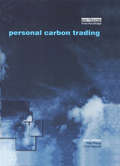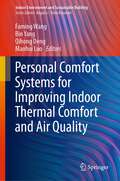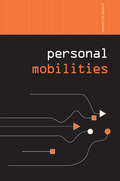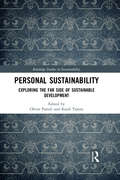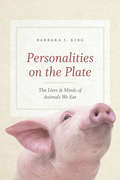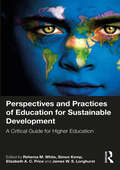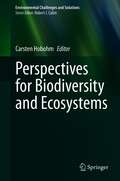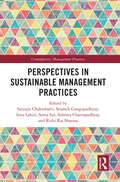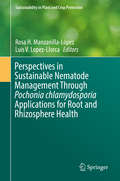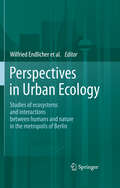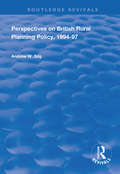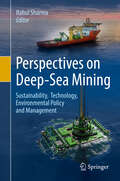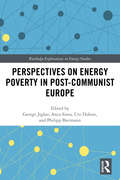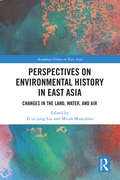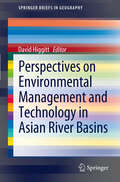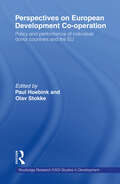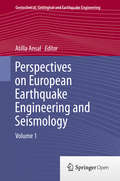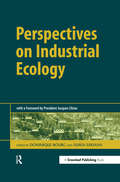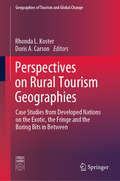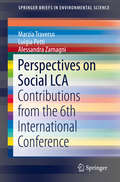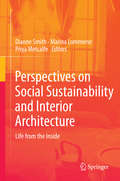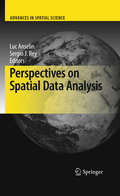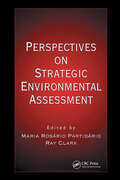- Table View
- List View
Personal Carbon Trading
by Tina Fawcett Yael ParagPersonal carbon trading is rapidly moving up the political agenda as recognition grows of its potential to address urgent issues of climate change and natural resource use. Under personal carbon trading schemes a carbon allowance would be allocated to each individual, to be used and traded in the same way as in national and international carbon trading schemes. This volume presents the latest research on personal carbon trading at different scales - from the effects on the individual, communities and organisations, to its place in national, EU (including the EU ETS) and global policy landscapes. It presents key research on the economic and policy barriers and implications, and will be essential reading for anyone involved in emissions trading research or policymaking.
Personal Comfort Systems for Improving Indoor Thermal Comfort and Air Quality (Indoor Environment and Sustainable Building)
by Bin Yang Faming Wang Maohui Luo Qihong DengThis book first describes fundamental knowledge on human thermal comfort, adaptive thermal comfort, thermal comfort in sleeping environments, modeling of human thermal comfort, and thermal comfort assessment using human trials. Next, it presents an in-depth review of concept progress and evaluation of various personal comfort system, summarizes important findings and feasible applications, current gaps as well as future research needs. The seven chapters included in this section are task/ambient conditioning systems, personalized ventilation systems, electric fans, personal comfort systems, thermoelectric systems, personal thermal management systems, and wearable personal thermal comfort systems. This book provides valuable guidance for personal comfort system design and further improvement on the personal comfort performance. It will be a valuable resource for academic researchers, engineers in industry, and government regulators in the field of sustainable buildings and built environment.
Personal Mobilities (Networked Cities Ser.)
by Aharon KellermanPersonal Mobilities provides a systematic study of personal movement focusing on the dimensions of space, individuals, societies and technologies. Kellerman examines a variety of personal mobilities, including air transportation, through several perspectives, examining the human need for movement, their anchoring within wider societal trends, commonalities and differences among mobility technologies and international differences. Although spatial mobility seems geographical by its very nature, the topic has been so far treated only partially, and mainly by sociologists. Personal Mobilities highlights geographical as well as sociological aspects and is the first book to focus solely on personal mobilities.
Personal Sustainability: Exploring the Far Side of Sustainable Development (Routledge Studies in Sustainability)
by Oliver Parodi Kaidi TammTransition to sustainability is stuck and academic research has not resulted in significant change so far. A large void in sustainability research and the understanding of sustainable development is an important reason for this. Personal Sustainability seeks to address this void, opening up a whole cosmos of sustainable development that has so far been largely unexplored. Mainstream academic, economic and political sustainable development concepts and efforts draw on the macro level and tend to address external, collective and global processes. By contrast, the human, individual, intra- and inter-personal aspects on the micro level are often left unaddressed. The authors of Personal Sustainability invite the reader on a self-reflecting journey into this unexplored inner cosmos of sustainable development, focusing on subjective, mental, emotional, bodily, spiritual and cultural aspects. Although these are intrinsically human aspects they have been systematically ignored by academia. To establish this new field in sustainability research means to leave the common scientific paths and expand the horizon. Together with authors from cultural studies, philosophy, anthropology, psychology, sociology, psychiatry, aesthetics and economics, and supported by contributions from practitioners, this book portrays different approaches to personal sustainability and reflects on their potentials and pitfalls, paving the way to cultures of sustainability. This book will be of great interest to researchers and students in the field of sustainability and sustainable development, as well as researchers from philosophy, anthropology, psychology, sociology, cultural studies, ethnology, educational research, didactics, aesthetics, economics, business and public administration.
Personalities on the Plate: The Lives & Minds of Animals We Eat
by Barbara J. KingIn recent years, scientific advances in our understanding of animal minds have led to major changes in how we think about, and treat, animals in zoos and aquariums. The general public, it seems, is slowly coming to understand that animals like apes, elephants, and dolphins have not just brains, but complicated inner and social lives, and that we need to act accordingly. Yet that realization hasn’t yet made its presence felt to any great degree in our most intimate relationship with animals: at the dinner table. Sure, there are vegetarians and vegans all over, but at the same time, meat consumption is up, and meat remains a central part of the culinary and dining experience for the majority of people in the developed world. With Personalities on the Plate, Barbara King asks us to think hard about our meat eating--and how we might reduce it. But this isn’t a polemic intended to convert readers to veganism. What she is interested in is why we’ve not drawn food animals into our concern and just what we do know about the minds and lives of chickens, cows, octopuses, fish, and more. Rooted in the latest science, and built on a mix of firsthand experience (including entomophagy, which, yes, is what you think it is) and close engagement with the work of scientists, farmers, vets, and chefs, Personalities on the Plate is an unforgettable journey through the world of animals we eat. Knowing what we know--and what we may yet learn--what is the proper ethical stance toward eating meat? What are the consequences for the planet? How can we life an ethically and ecologically sound life through our food choices? We could have no better guide to these fascinatingly thorny questions than King, whose deep empathy embraces human and animal alike. Readers will be moved, provoked, and changed by this powerful book.
Perspectives and Practices of Education for Sustainable Development: A Critical Guide for Higher Education
by Simon Kemp Rehema M. White Price, Elizabeth A. C. Longhurst, James W. S.Informed by theory and full of practical advice, this key title offers a clear route to education for sustainable development (ESD) whilst questioning how we reconcile participatory, inclusive processes and the urgency of global crises.This handbook provides guidance for those with an interest in the purpose and direction of learning and the principles and practices of sustainability in universities in the UK and beyond. With critical analysis and useful case studies and recommendations, the book covers key topics such as: The need for sustainable development and the role that universities can play in this Showing how ESD should be part of a whole institution approach Development of relevant curricula with innovative and inspiring pedagogies to support sustainability competencies Transdisciplinary learning and pioneering forms of knowledge production Graduate futures and emerging priorities in the field of ESD Through detailed case studies from experts in the field, this book demonstrates how ESD enables a critical interrogation of our world and strengthens the capacities of our universities to nurture future thinking leaders.This is essential reading for all those interested in beginning or widening ESD in programmes, universities and the wider sector, including academic staff, university senior managers and support staff, students, policy makers, employers, and community leaders.
Perspectives for Biodiversity and Ecosystems (Environmental Challenges and Solutions)
by Carsten HobohmThe novelty of the book is a strong focus on perception, perspectives and prediction by scientists with profound insight into the ecology of ecosystems or into human demands and activity. The challenge is to bridge from empirical data and the knowledge of the past to the possibilities of the performance in the future. We assume that there is scope for more cooperation between the fields of ecology and practical philosophy or other social sciences in organising ecosystems and shaping the cultural future of humankind, and that such collaboration should be accorded considerably more priority. This book deals with environmental processes seen within a framework of the nature of ecosystems and human cultures. The future of the environment, the development of ecosystems and effective nature conservation management are the essentials of this book. Human nature and culture, and in particular their interactions, are interpreted as a set of rules and as given. The aim is not only to assess the significance of human influence on species composition and biodiversity but also to weigh up the subsequent potentials for action. In this book we will analyze the problems independently of one another, even if they are interconnected. This book focuses on perspectives and prognoses for the impacts of anthropogenic activity on ecosystems and thus on species conservation. Its goal is to improve assessments of the impacts of human activity on the environment. We are aware that prognoses have very often proven to be false. It is difficult to impossible to be able to predict with precision how evolution and ecosystems will change in future under anthropogenic influence. This strengthens our resolve to attempt to retain the highest possible degree of scientific integrity and professionalism and not to shy away from expressing the uncertainty of our own ideas and prognoses. We venture prognoses in this book and we will fail. However, we hope that we will be wrong on the right side.
Perspectives in Sustainable Management Practices (Contemporary Management Practices)
by Satyajit Chakrabarti, Soumik Gangopadhyay, Isita Lahiri, Soma Sur, Subrata Chattopadhyay and Rishi Raj SharmaEmbracing sustainable management practices is important for businesses and commercial organizations wishing to responsibly contribute to the socioeconomic development of societies and communities. This book provides insights into recent trends, issues, and challenges in embracing these practices, while promoting growth and innovation in business. The COVID-19 pandemic has redefined the necessity of implementing sustainable practices. This book looks at the process, implementation, and evaluation of sustainable practices in the social and commercial sectors in recent years. With case studies from different industries, these chapters explore and document creative applications of effective measures to chart out financial growth for businesses while reducing carbon emissions, focusing on corporate social responsibility, and working toward socio-economic sustainability for workers and communities, among others. They also examine how these innovative strategies can be scaled up and applied across diverse industries, for small and large businesses, and in different economic environments. Part of the Contemporary Management Practices series, this book will be useful to practising managers, researchers, and students who are interested in business strategy, financial strategy, and social inclusion. It will be especially of use to those working in the areas of corporate governance, corporate social responsibility, green marketing, corporate finance, and organizational performance.
Perspectives in Sustainable Nematode Management Through Pochonia chlamydosporia Applications for Root and Rhizosphere Health
by Rosa H. Manzanilla-López Luis V. Lopez-LlorcaThis volume reviews our current knowledge and novel research areas on Pochonia chlamydosporia, a cosmopolitan fungus occurring in soils as a saprophyte yet capable of colonizing the rhizosphere of crops as an endophyte and behaving as a parasite of eggs of plant-parasitic nematodes. The book is divided into six sections containing 18 chapters, starting with a historical background chapter, followed by 16 chapters, each contributed by experts, concerning those key aspects necessary to work with this biocontrol agent in a multidisciplinary treatise. Topics covered include systematics, biology, nematode-fungus interactions, nematode management strategies, secondary metabolites, and other methods including more novel research areas such as molecular, –omics, plant growth enhancement and endophytic abilities of P. chlamydosporia. The final chapter deals with the future perspectives of P. chlamydosporia research.
Perspectives in Urban Ecology
by Wilfried EndlicherThis book gives an interdisciplinary overview on urban ecology. Basic understanding of urban nature development and its social reception are discussed for the European Metropolitan Area of Berlin. Furthermore, we investigate specific consequences for the environment, nature and the quality of life for city dwellers due to profound changes such as climate change and the demographic and economic developments associated with the phenomena of shrinking cities. Actual problems of urban ecology should be discussed not only in terms of natural dimensions such as atmosphere, biosphere, pedosphere and hydrosphere but also in terms of social and cultural dimensions such as urban planning, residence and recreation, traffic and mobility and economic values. Our research findings focus on streets, new urban landscapes, intermediate use of brown fields and the relationships between urban nature and the well-being of city dwellers. Finally, the book provides a contribution to the international discussion on urban ecology.
Perspectives on British Rural Planning Policy, 1994-97 (Routledge Revivals)
by Andrew W. GilgFirst published in 1999, this volume explores the issue of rural planning, which has become a complex activity in which policies in one area have important ramifications in other policy areas. It is thus very important for all those involved in rural planning affairs to remain not only up to date, but to place recent developments in a longer perspective. This new series aims to answer all these needs by providing an accurate and informed account of recent developments in North American, British and European rural policy, and critiques of policy implementation and its impacts from new material and from analyses of published research findings. This second volume in the series covers the last few years of the John Major administration until the election of the Tony Blair government in May 1997. It is divided into six chapters: overview of changes affecting all rural planning activities; the environment; town and country planning; extensive land uses; nature conservation and recreation; and social land economic issues. The next British volume will cover the entire period of the current government, with successive volumes covering each new government as it unfolds.
Perspectives on Deep-Sea Mining: Sustainability, Technology, Environmental Policy and Management
by Rahul SharmaThis book is a sequel to ’Deep-Sea Mining: Resource Potential, Technical and Environmental Considerations’ (2017) and ‘Environmental Issues of Deep-Sea Mining: Impacts, Consequences and Policy Perspectives’ (2019), and aims to provide a comprehensive volume on different perspectives of deep-sea mining from specialists around the world. The work is timely, as deep-sea minerals continue to enthuse researchers involved in activities such as ascertaining their potential as alternative sources for critical metals for green energy and other industrial applications, as well as technology development for their sustainable exploration and exploitation, while addressing environmental concerns. With a steady increase in the number of contractors having exclusive rights over large tracts of seafloor in the ‘Area’, i.e. area beyond national jurisdictions, the International Seabed Authority, mandated with the responsibility of regulating such activities, is in the process of developing a code for exploitation of deep-sea minerals. These, coupled with growing interest among private entrepreneurs, investment companies and policy makers, underscore the need for updated information to be made available in one place on the subject of deep-sea mining. The book evaluates the potential and sustainability of mining for deep-sea minerals compared to other land-based deposits, the technologies needed for mining and processing of ores, the approach towards environmental monitoring and management, as well as the regulatory frameworks and legal challenges to manage deep-sea mining activities. The book is expected to serve as an important reference for all stakeholders including researchers, contractors, mining companies, regulators and NGOs involved in deep-sea mining.
Perspectives on Earthquake Geotechnical Engineering
by Atilla Ansal Mohamed SakrThis book offers a broad perspective on important topics in earthquake geotechnical engineering and gives specialists and those that are involved with research and application a more comprehensive understanding about the various topics. Consisting of eighteen chapters written by authors from the most seismic active regions of the world, such as USA, Japan, Canada, Chile, Italy, Greece, Portugal, Taiwan, and Turkey, the book reflects different views concerning how to assess and minimize earthquake damage. The authors, a prominent group of specialists in the field of earthquake geotechnical engineering, are the invited lecturers of the International Conference on Earthquake Geotechnical Engineering from Case History to Practice in the honour of Professor Kenji Ishihara held in Istanbul, Turkey during 17-19 June 2013.
Perspectives on Energy Poverty in Post-Communist Europe (Routledge Explorations in Energy Studies)
by Anca Sinea George Jiglau Ute Dubois Philipp BiermannThis book explores the issue of energy poverty in post-communist Europe and shows how it is viewed and addressed through public policies. Energy poverty is severely affecting many parts of the European Union, but up until now only a few comparative analyses have been developed to understand the phenomenon and its diversity throughout the region. Filling this gap, this volume focuses specifically on the Eastern European region, drawing on contributions that cover a wide range of countries including Germany, Hungary, Poland, and Romania. This region has undergone significant transitions over the past three decades, but, as the contributions demonstrate, it still faces major challenges to providing clean and affordable energy to its citizens and renovating existing housing stock. The chapters explore the extent of energy poverty in each country and examine the drivers, while casting light on how policy-makers tackle the issue through a critical examination of the instruments implemented to help energy poor people. This book will be of great interest to researchers in the fields of energy policy and comparative politics, to policy-makers in post-communist countries and EU institutions, and also to other relevant actors, such as companies and NGOs who focus on issues of energy poverty.
Perspectives on Environmental History in East Asia: Changes in the Land, Water and Air (Academia Sinica on East Asia)
by Ts’ui-jung Liu; Micah MuscolinoThis edited volume engages with some of the most dynamic themes in current research on East Asian environmental history, including agricultural science, war and the environment, imperial forestry, oceanic history, and the history of energy. Chapters in this book supply an overview of environmental history as a rapidly expanding field, continuing to generate valuable insights into the mutually constitutive relationship between human societies and the biophysical environment. The book is divided into three parts: Part I consists of three chapters related to land use, while Part II includes five chapters that focus on water, a topic of perennial concern among environmental historians of East Asia, especially as it relates to irrigation, food production, and marine fisheries. Part III consists of two chapters, discussing the impact of new technologies on air quality, in addition to the history of energy in East Asia, which has emerged as an important area of inquiry at the intersection between both environmental history and the history of science and technology. Perspectives on Environmental History in East Asia: Changes in the Land, Water, and Air will appeal to students and scholars of East Asian studies, environmental history, and environmental sciences.
Perspectives on Environmental Management and Technology in Asian River Basins
by David HiggittAsian river basins are undergoing rapid transformation. This volume considers the implications of the environmental change-development nexus for water management, river health and hazard awareness. As Biswas and Tortajada (2011) have recently commented, water management in Asia will likely change more in the next twenty years than in the last 2000 years. Critical environmental trends include decreasing flows of water and sediment due to dam construction and increased water extraction, land use change (especially forest removal), encroachment and degradation of floodplain and wetland environments, increased water demand and concerns about water security, urban expansion and associated pollution of rivers and contamination of groundwater reserves. These challenges are being reframed by new approaches to water management which represent a transition from engineering-dominated approaches towards integrated water management, from technology transfer to adaptive technologies. The volume comprises an introduction and five chapters. Brierley and Callum reframe approaches to river repair within emerging theories of in ecology and earth science which regard nature as a complex adaptive system replete with inherent uncertainties. These ideas are mirrored in the four case study chapters which deal with water governance in the Mekong Basin (Hirsch); hybrid adoption of water resource technologies in India (Barbanente et al.); determination of sediment dynamics in Java Rijsdijk); and ecological conservation imperatives in the headwaters of the Yellow, Yangtze and Mekong rivers in western China (Li et al.).
Perspectives on European Development Cooperation: Policy and Performance of Individual Donor Countries and the EU (Routledge Research EADI Studies in Development)
by Paul Hoebink Olav StokkeEvents of the past twenty years, including the Cold War and the War on Terror, have meant that the environments of international development co-operation have changed extensively, with dramatic consequences for development policies and North-South relations in general. Perspectives on European Development Cooperation takes stock of such changes, describing and analyzing the new European development agenda, including the role of the European Union. Essays by prominent authorities in the field examine the development policies of individual donor countries and focus on the principles and objectives governing aid strategies and the performances of these policies. This book will be of interest to students of development studies and those involved in determining development policy.
Perspectives on European Earthquake Engineering and Seismology
by Atilla AnsalThis book collects 5 keynote and 15 topic lectures presented at the 2nd European Conference on Earthquake Engineering and Seismology (2ECEES), held in Istanbul, Turkey, from August 24 to 29, 2014. The conference was organized by the Turkish Earthquake Foundation - Earthquake Engineering Committee and Prime Ministry, Disaster and Emergency Management Presidency under the auspices of the European Association for Earthquake Engineering (EAEE) and European Seismological Commission (ESC). The book's twenty state-of-the-art papers were written by the most prominent researchers in Europe and address a comprehensive collection of topics on earthquake engineering, as well as interdisciplinary subjects such as engineering seismology and seismic risk assessment and management. Further topics include engineering seismology, geotechnical earthquake engineering, seismic performance of buildings, earthquake-resistant engineering structures, new techniques and technologies and managing risk in seismic regions. The book also presents the Third Ambraseys Distinguished Award Lecture given by Prof. Robin Spence in honor of Prof. Nicholas N. Ambraseys. The aim of this work is to present the state-of-the art and latest practices in the fields of earthquake engineering and seismology, with Europe's most respected researchers addressing recent and ongoing developments while also proposing innovative avenues for future research and development. Given its cutting-edge content and broad spectrum of topics, the book offers a unique reference guide for researchers in these fields. Audience: This book is of interest to civil engineers in the fields of geotechnical and structural earthquake engineering; scientists and researchers in the fields of seismology, geology and geophysics. Not only scientists, engineers and students, but also those interested in earthquake hazard assessment and mitigation will find in this book the most recent advances.
Perspectives on Industrial Ecology
by Suren Erkman Dominique Bourg President Jacques ChiracBusiness-as-usual in terms of industrial and technological development – even if based on a growing fear of pollution and shortages of natural resources – will never deliver sustainable development. However, the growing interest in recent years in the new science of industrial ecology (IE), and the idea that industrial systems should mimic the quasi-cyclical functions of natural ecosystems in an 'industrial food chain', holds promise in addressing not only short-term environmental problems but also the long-term holistic evolution of industrial systems. This possibility requires a number of key conditions to be met, not least the restructuring of our manufacturing and consumer society to reduce the effects of material and energy flows at the very point in history when globalisation is rapidly increasing them. This book sets out to address the theoretical considerations that should be made implicit in future research as well as practical implementation options for industry. The systematic recovery of industrial wastes, the minimisation of losses caused by dispersion, the dematerialisation of the economy, the requirement to decrease our reliance on fuels derived from hydrocarbons and the need for management systems that help foster inter-industry collaboration and networks are among the topics covered. The book is split into four sections. First, the various definitions of IE are outlined. Here, important distinctions are made between industrial metabolism and IE. Second, a number of different industrial sectors, including glass, petroleum and electric power, are assessed with regard to the operationalisation of industrial ecology. Eco-industrial Parks and Networks are also analysed. Third, the options for overcoming obstacles that stand in the way of the closing of cycles such as the separation and screening of materials are considered and, finally, a number of implications for the future are assessed. The contributions to Perspectives on Industrial Ecology come from the leading thinkers working in this field at the crossroads between a number of different disciplines: engineering, ecology, bio-economics, geography, the social sciences and law.
Perspectives on Rural Tourism Geographies: Case Studies from Developed Nations on the Exotic, the Fringe and the Boring Bits in Between (Geographies of Tourism and Global Change)
by Rhonda L. Koster Doris A. CarsonThis book examines rural tourism across three different contexts, acknowledging the complexity of rural places. It applies a systematic comparative framework across nine case studies from Australia, Canada and Sweden. The case studies address the uniqueness of different rural spaces, while the framework incorporates many theoretical aspects from human geography including spatial, historic, institutional, demographic, socio-economic and network perspectives. In the course of applying this comparative case study framework, the book identifies numerous implications for planning and policy in rural settings. These contributions from international, expert authors help to identify the opportunities and challenges that affect rural regions, from places at the urban fringe to exotic remote spaces and taking in the ‘boring bits in between.’ Both the analysis and the framework used will be of value to scholars and students of rurality, tourism, regional development, rural policy, geography, and destination management. Readers will gain a deeper understanding of the rural context in developed countries and a robust conceptualization of rural tourism geographies.
Perspectives on Social LCA: Contributions from the 6th International Conference (SpringerBriefs in Environmental Science)
by Luigia Petti Marzia Traverso Alessandra ZamagniThis book gives a selection of contributions from the 6th Social Life Cycle Assessment (S-LCA) Conference in Pescara, Italy. S-LCA is a social (real and potential) impact assessment method that aims to drive improvements in order to increase the value of products and services. It helps organizations to plan better, implement more effectively, and promote scale initiatives. More in general, the assessment activity also facilitates accountability and supports stakeholder communication. Consumers are greatly aware of the provenance of the goods they purchase. They have greater access to product information than ever before, also thanks to the new digital platforms. They are also empowered to make more responsible purchase decisions about what concerns sustainability aspects. Therefore the need to linger on the social aspects has been emerging recently. Although the business evolution of environmental methods and metrics has advanced significantly over the past decades, tools and metrics to estimate the social aspects of products and services are in progress. In this volume several sections provide methodological developments and tool focus, contextualizing S-LCA scientifically and explore the fields of applications. Through current development (conferences, articles, seminars and industry group publications), the method is spreading, evolving and gaining in maturity. However, it still is an evolving field, and main developments foresee, both at the level of methodology and results, interpretation and communication in order to find a path forward. S-LCA has been changing since the beginnings. From our observations as educators, researchers, practitioners, and peer reviewers in the S-LCA community, there are trends that are of importance us.
Perspectives on Social Sustainability and Interior Architecture
by Dianne Smith Marina Lommerse Priya MetcalfeThis book argues that interior architects have a responsibility to practice their profession in collaborative ways that address the needs of communities and of to be the agents of social justice and cultural heritage. The book is divided into three sections, based on three pivotal themes -- community engagement, social justice and cultural heritage. Each section has chapters that put forward the principles of these themes, leading into a variety of fascinating case studies that illustrate how socially sustainable design is implemented in diverse communities across the world. The second section includes four concise case studies of community housing issues, including remote-area indigenous housing and housing for the homeless. The third section offers two extensively researched essays on design and cultural heritage -- a case study of the development of a redundant industrial site and a historical study of gendered domestic interiors. The book appeals to a wider audience than the design community alone and challenges mainstream interior design/interior architecture practitioners nationally and internationally to take a leading role in the field of socially responsible design. The issues raised by the authors are relevant for individuals, communities, government and non-government organisations, professionals and students. "In the twenty-first century we seem to have entered into a new world of knowledge discovery, where many of the most exciting insights come not from the authority of a traditional discipline, but from the dialogue that happens at the hubs and intersections of thought -- the arenas where different disciplines and approaches, different schools and habits of thinking, come together to collaborate and contend. This collection is a good example of this, and I hope the book will be widely read and its lessons learned and applied. " Tim Costello, Officer of the Order of Australia, Chief Executive, World Vision Australia.
Perspectives on Spatial Data Analysis
by Luc Anselin Sergio J. ReyThis book takes both a retrospective and prospective view of the field of spatial analysis by combining selected reprints of classic articles by Arthur Getis with current observations by leading experts in the field. Four main aspects are highlighted, dealing with spatial analysis, pattern analysis, local statistics as well as illustrative empirical applications. Researchers and students will gain an appreciation of Getis' methodological contributions to spatial analysis and the broad impact of the methods he has helped pioneer on an impressively broad array of disciplines including spatial epidemiology, demography, economics, and ecology. The volume is a compilation of high impact original contributions, as evidenced by citations, and the latest thinking on the field by leading scholars. This makes the book ideal for advanced seminars and courses in spatial analysis as well as a key resource for researchers seeking a comprehensive overview of recent advances and future directions in the field.
Perspectives on Spin Glasses
by Pierluigi Contucci Cristian GiardinàPresenting and developing the theory of spin glasses as a prototype for complex systems, this book is a rigorous and up-to-date introduction to their properties. The book combines a mathematical description with a physical insight of spin glass models. Topics covered include the physical origins of those models and their treatment with replica theory; mathematical properties like correlation inequalities and their use in the thermodynamic limit theory; main exact solutions of the mean field models and their probabilistic structures; and the theory of the structural properties of the spin glass phase such as stochastic stability and the overlap identities. Finally, a detailed account is given of the recent numerical simulation results and properties, including overlap equivalence, ultrametricity and decay of correlations. The book is ideal for mathematical physicists and probabilists working in disordered systems.
Perspectives on Strategic Environmental Assessment
by Ray Clark Maria Rosário PartidárioAn environmental assessment must be performed whenever a property transaction takes place. Those who donít may find themselves responsible for the past misdeeds of others. This book contains contributions by professionals from various locations who use Strategic Environmental Assessment (SEA) as a tool applied to water management issues. SEA helps make decisions that increase sustainability. Because of its procedural nature, it necessarily becomes tailor-made to different applications. Easily understood and geographic in scope, this book presents leading edge thinking and first hand knowledge on the applications of SEA in water management.Perspectives on Strategic Environmental Assessment is a comprehensive guidebook for performing environmental assessments all over the world. No other source provides you with as much information on the applications of SEA as a policy assessment and management tool. This book provides a blueprint for environmental assessments that safeguards you from the oversights of others.
